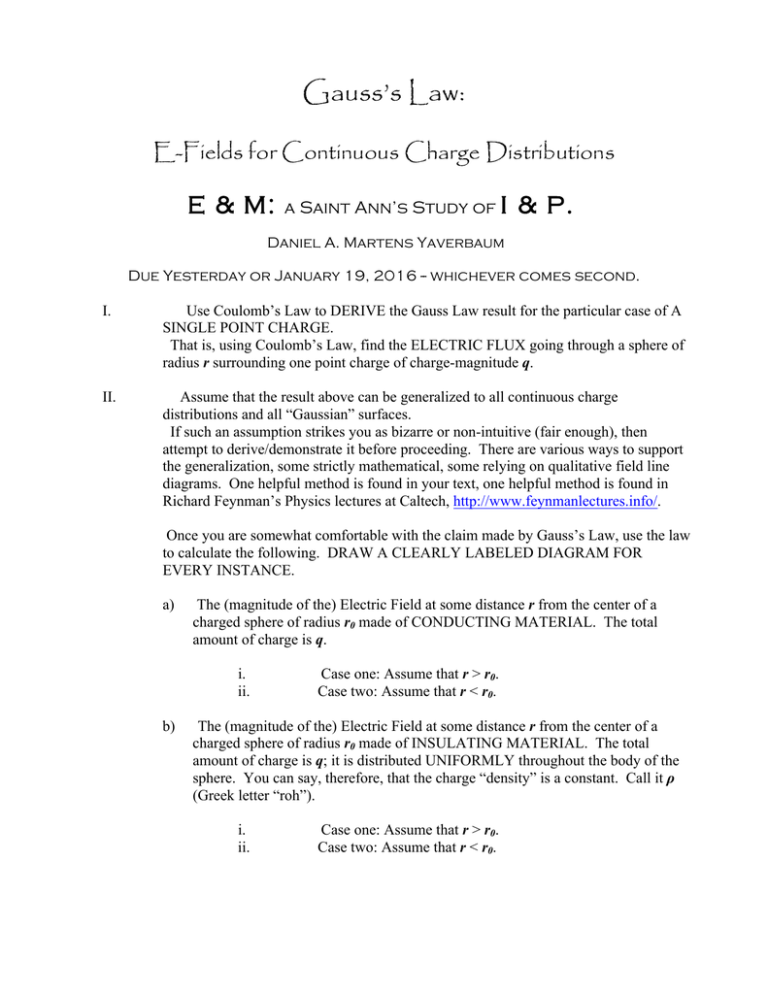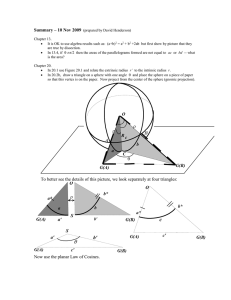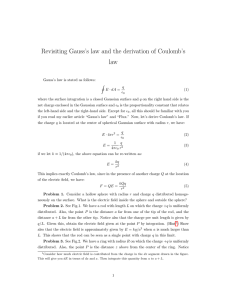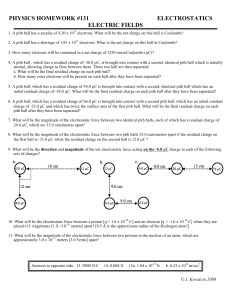Gauss`s Law - Daniel Yaverbaum
advertisement

Gauss’s Law: E-Fields for Continuous Charge Distributions E & M: a Saint Ann’s Study of I & P. Daniel A. Martens Yaverbaum Due Yesterday or January 19, 2016 -- whichever comes second. I. Use Coulomb’s Law to DERIVE the Gauss Law result for the particular case of A SINGLE POINT CHARGE. That is, using Coulomb’s Law, find the ELECTRIC FLUX going through a sphere of radius r surrounding one point charge of charge-magnitude q. II. Assume that the result above can be generalized to all continuous charge distributions and all “Gaussian” surfaces. If such an assumption strikes you as bizarre or non-intuitive (fair enough), then attempt to derive/demonstrate it before proceeding. There are various ways to support the generalization, some strictly mathematical, some relying on qualitative field line diagrams. One helpful method is found in your text, one helpful method is found in Richard Feynman’s Physics lectures at Caltech, http://www.feynmanlectures.info/. Once you are somewhat comfortable with the claim made by Gauss’s Law, use the law to calculate the following. DRAW A CLEARLY LABELED DIAGRAM FOR EVERY INSTANCE. a) The (magnitude of the) Electric Field at some distance r from the center of a charged sphere of radius r0 made of CONDUCTING MATERIAL. The total amount of charge is q. i. ii. b) Case one: Assume that r > r0. Case two: Assume that r < r0. The (magnitude of the) Electric Field at some distance r from the center of a charged sphere of radius r0 made of INSULATING MATERIAL. The total amount of charge is q; it is distributed UNIFORMLY throughout the body of the sphere. You can say, therefore, that the charge “density” is a constant. Call it ρ (Greek letter “roh”). i. ii. Case one: Assume that r > r0. Case two: Assume that r < r0. III. Use Gauss’s Law to calculate the following (DRAW DIAGRAMS FOR EVERYTHING!): a) The Electric Field at some perpendicular distance r from a LINE OF total CHARGE q, length L. Assume that q is uniformly distributed along the line. You can say, therefore, that the 1-D charge “density” is a constant. Call it λ (Greek letter “lambda”). Also, assume the line’s length is “functionally infinite”. That is, assume that r << L is so that the test charge cannot “see” (experience the effects of) the line ends. b) The (magnitude of the) Electric Field at some distance r from the center axis of a charged CYLINDER (tube, whatever) of radius r0 made of CONDUCTING MATERIAL. The total amount of charge is q. Length L, 1-D charge density λ. Again, r << L. i. ii. c) Case one: Assume that r > r0. Case two: Assume that r < r0. The (magnitude of the) Electric Field at some distance r from the center axis of a charged CYLINDER (tube, whatever) of radius r0 made of INSULATING MATERIAL. The total amount of charge is q. Length L, 1-D charge density λ. Again, r << L. i. ii. Case one: Assume that r > r0. Case two: Assume that r < r0. IV. Assume that the electric potential, V, is defined to approach 0 as r approaches infinity. Then, as a function of r for each of the cases above, calculate both the electric potential, V, and the capacitance, C, due to the given charge configuration.



